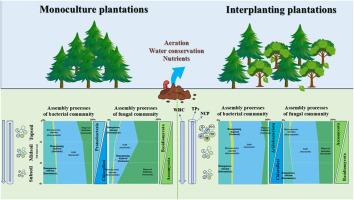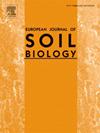Interplanting Phoebe bournei modifies soil microbial community characteristics in Cunninghamia lanceolata monocultures
IF 3.3
2区 农林科学
Q1 ECOLOGY
引用次数: 0
Abstract
The prolonged monoculture of Cunninghamia lanceolata depletes soil fertility, making the introduction of broadleaf trees—Phoebe bournei indispensable for soil restoration—yet its impact on the belowground ecological environment remains inadequately explored. Here, we investigated how uneven-aged interplanting of P. bournei in subtropical C. lanceolata stands alters microbial community characteristics and correlates with major edaphic variables across 0–60 cm soil profile. Interplanting P. bournei improved soil aeration, water conservation, and nutrient availability, driving significant shifts in bacterial and fungal β-diversity and partial but significant changes in community composition. It also enhanced ecological drift and reduced dispersal limitation, strengthening homogeneous selection in bacterial communities (0–40 cm) while promoting drift in fungal communities (0–60 cm). These structural and assembly changes suggest potential functional alterations in organic-matter degradation and nutrient cycling. Interplanting P. bournei led to marked improvements in soil microbial ecology, as evidenced by higher abundances of Acidobacteria and Ascomycota, indicative of enhanced complex-carbon degradation; elevated bacterial cellulolytic capacity and accelerated organic-matter turnover; promotion of saprotroph–symbiotroph nutrition; and reduced subsoil pathotroph abundance, which may indirectly support C. lanceolata health. Lastly, soil nutrient elements (e.g., soil organic carbon, total phosphorus) and enzyme activities (e.g., Cellobiohydrolase, Sucrase) were identified as key drivers of microbial community structure and functional potential, highlighting their critical roles in shaping soil microbial ecosystems. In summary, uneven-aged interplanting P. bournei in C. lanceolata plantations optimized soil ecosystem functions, offering a sustainable strategy to enhance forest productivity and improve soil health.

间作杉木对杉木单作土壤微生物群落特征的影响
杉木的长期单一栽培消耗了土壤肥力,因此引入阔叶树——杉木是恢复土壤不可缺少的手段,但其对地下生态环境的影响尚未得到充分的探讨。本文以亚热带杉木林为研究对象,研究了不均匀套种林龄对微生物群落特征的影响及其与0 ~ 60 cm土壤剖面主要土壤变量的关系。套种柏树改善了土壤的通气性、保水性和养分有效性,显著改变了细菌和真菌的β-多样性和部分但显著的群落组成。它还增强了生态漂变,减少了扩散限制,加强了细菌群落(0-40 cm)的同质选择,同时促进了真菌群落(0-60 cm)的漂变。这些结构和组装的变化表明有机物降解和养分循环的潜在功能改变。土壤中酸菌群和子囊菌群的丰度显著提高,表明复合碳降解能力增强;提高细菌的纤维素分解能力和加速有机物的周转;腐养-共生营养促进;土壤病原菌丰度降低,可能间接支持杉木的健康。最后,土壤养分元素(如土壤有机碳、全磷)和酶活性(如纤维素生物水解酶、蔗糖酶)被认为是微生物群落结构和功能潜力的关键驱动因素,强调了它们在塑造土壤微生物生态系统中的关键作用。综上所述,间作杉木优化了土壤生态系统功能,为提高森林生产力和改善土壤健康提供了可持续的策略。
本文章由计算机程序翻译,如有差异,请以英文原文为准。
求助全文
约1分钟内获得全文
求助全文
来源期刊

European Journal of Soil Biology
环境科学-生态学
CiteScore
6.90
自引率
0.00%
发文量
51
审稿时长
27 days
期刊介绍:
The European Journal of Soil Biology covers all aspects of soil biology which deal with microbial and faunal ecology and activity in soils, as well as natural ecosystems or biomes connected to ecological interests: biodiversity, biological conservation, adaptation, impact of global changes on soil biodiversity and ecosystem functioning and effects and fate of pollutants as influenced by soil organisms. Different levels in ecosystem structure are taken into account: individuals, populations, communities and ecosystems themselves. At each level, different disciplinary approaches are welcomed: molecular biology, genetics, ecophysiology, ecology, biogeography and landscape ecology.
 求助内容:
求助内容: 应助结果提醒方式:
应助结果提醒方式:


